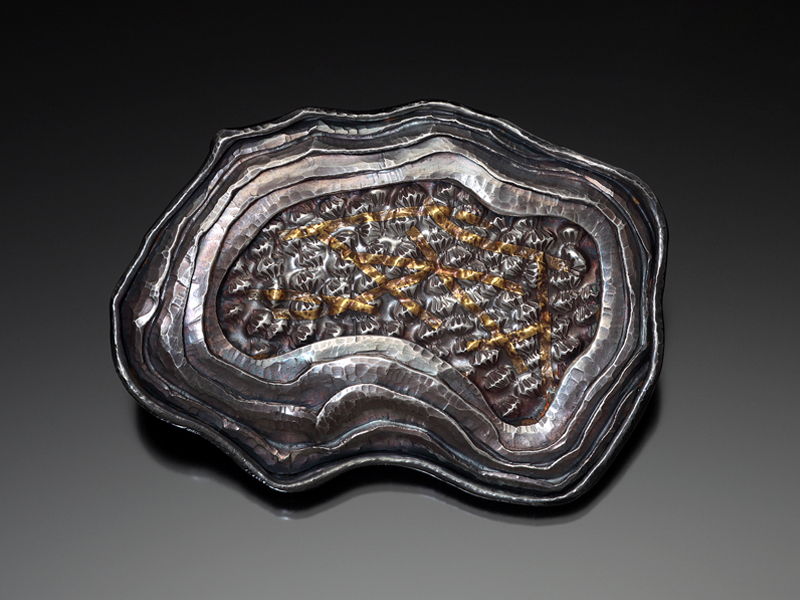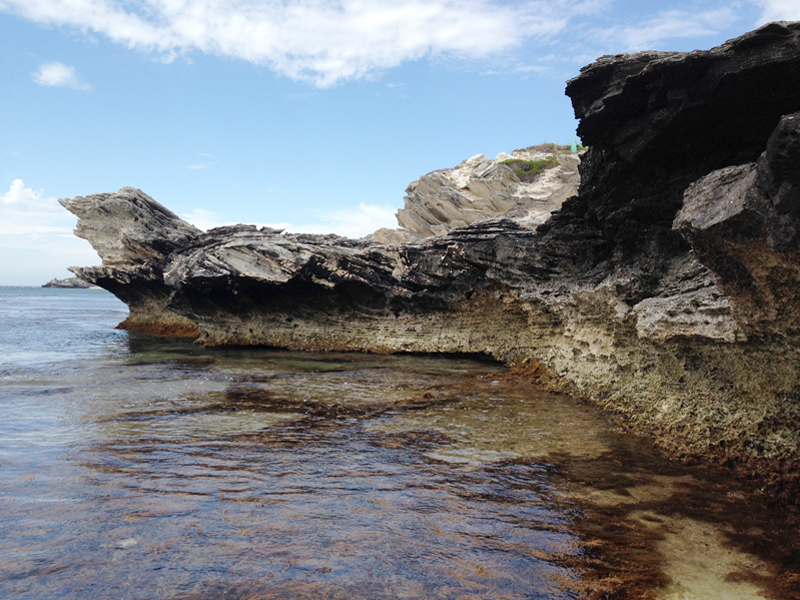
Facèré Jewelry Art Gallery recently presented Marine Life Evolved, an exhibition of new work by Nancy Mēgan Corwin inspired by the artist’s extensive travels, collection, and study of sea-based life. With a close attention to detail and pattern, Corwin reimagines the natural world through her jewelry.
Sandra Wilson: Can you please first tell us a little about your training and background as a jeweler?
Nancy Mēgan Corwin: I have always loved making things, but never considered applied art as a career until I went to college. I started out majoring in music and decided to take a course in drawing as a relief from practice halls and sight-reading classes. This was in 1969 and things were changing in the colleges. Halfway through the term, my drawing teacher decided to switch us to either metals or ceramics. He left it up to us and we all chose metals. The first time I touched silver, I knew that metalwork would be my passion and my future. After I received my BA, I moved to Boston and worked as a bench jeweler during the day and on commissions in my own studio at night. After a while, the production aspect of my day job began to dampen my creative energies and I decided to go to graduate school, where I studied with Eleanor Moty and Fred Fenster at the University of Wisconsin-Madison.
When did you first encounter chasing and repoussé, and why did you decide to specialize in this technique?
Nancy Mēgan Corwin: Eleanor Moty introduced my graduate group to chasing and repoussé. She taught us both the classic European style of creating form by punching from the back of the sheet metal (repoussé) with steel punches, and detailing the front side with smaller steel tools we made (chasing). Eleanor also shared what she learned from the Japanese master Satuso Ando, who led workshops in the United States to teach educators the Japanese style of chasing, called uchidashi, in which most of the forming work is done from the front side of the sheet. Eleanor is a consummate artist and an excellent teacher. I owe her a great deal for not only introducing me to these techniques and how to make the tools to practice them, but for emphasizing a high level of technical skill.
From the first, the processes of chasing and repoussé have felt natural and right. Through them I was able to “converse” with the metal, resulting in the ability to manipulate silver and copper to express and interpret various aspects of the unique forms and textures that are reflected in the natural world. These techniques allow me to create an organic look from material that is man-made and highly inorganic. Metal has the quality I desire to make permanent that which is fleeting.

Is this technique something that you feel has a parallel in the natural world? And if so, how?
Nancy Mēgan Corwin: For the most part I work intuitively. The textures I develop are a response to elements in the natural world, but are not reproductions. They grow from this conversation with the metal that is part of my practice. That growth, from one form to another, is analogous to the stages in the life cycles of plants and sea life. In almost every case, the piece I have roughly designed evolves as the metal responds to my process. The metal feels alive and my role is to bring out what is hidden within.
There is also the sense of time. Many art jewelers and those with a production line find chasing and repoussé too “time consuming” relative to other metalsmithing processes. It is exactly that slow, meditative, and reflective aspect of these processes that I love. Time actually disappears as an element of my studio experience when I am chasing or forming a piece of metal in this way. The natural world has its own sense of time, both seasonal and individual. As a gardener, I am constantly struck by how difficult it is to try to “force” a plant—to make it develop faster, bloom earlier, produce food before it’s time. The same happens in the studio when I try to rush a piece by forcing a texture or form rather than taking the necessary time to allow it to develop.
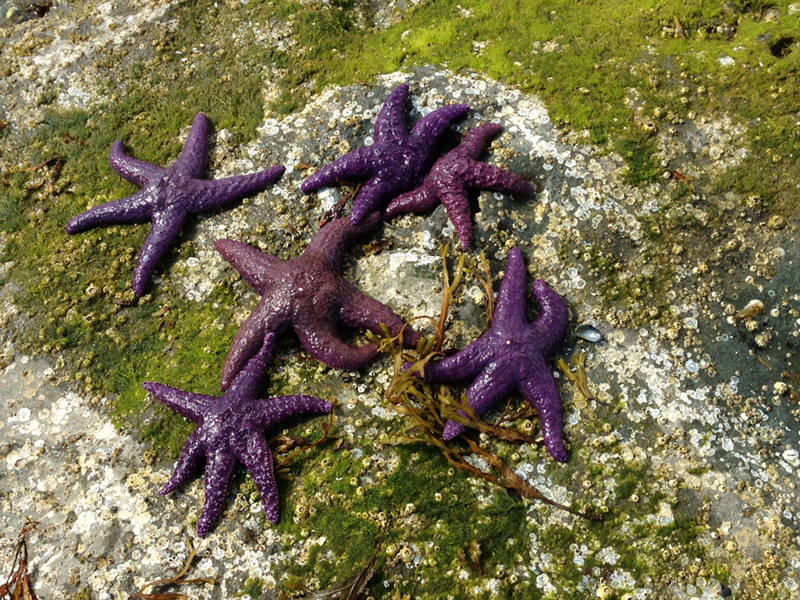
Do you have a favorite tool? Is there one that you really do not like?
Nancy Mēgan Corwin: All the tools I use for chasing and repoussé are my favorites, from the pitch bowl to the chasing hammer. I have about 10 chasing tools I use the most and never want to be without. However, altogether I must have about 200 chasing tools and repoussé punches.
My least favorite tool is a hammer hand piece for the pendant motor. I know many jewelers like it for setting stones, but I prefer to control the force and type of strike I use.
You have a strong interest in the natural world, which manifests itself through the close observation of nature’s forms, and their reinterpretation in metal. There is a look and famous lineage of silver– and goldsmiths who have walked this skilled path before—from Cellini to Buccellati. How do you feel about that lineage?
Nancy Mēgan Corwin: I share a process with silver- and goldsmiths from around the world that for thousands of years has been repeatedly used to express a love of the natural world. In my travels around the world, it has become very clear that a particular aspect of the natural world may inspire the individual artisan, but it is expressed not only with a personal style, but also often within a cultural context. Greek silver and gold work is very different from Mexican. Japanese design may sometimes influence European work, but the two are ultimately very different.
Although I study both historic and contemporary metalwork, my personal goals are to create a unique body of work in which the design does not reflect a specific lineage or cultural point of view, while using techniques that have a strong history in many cultures.
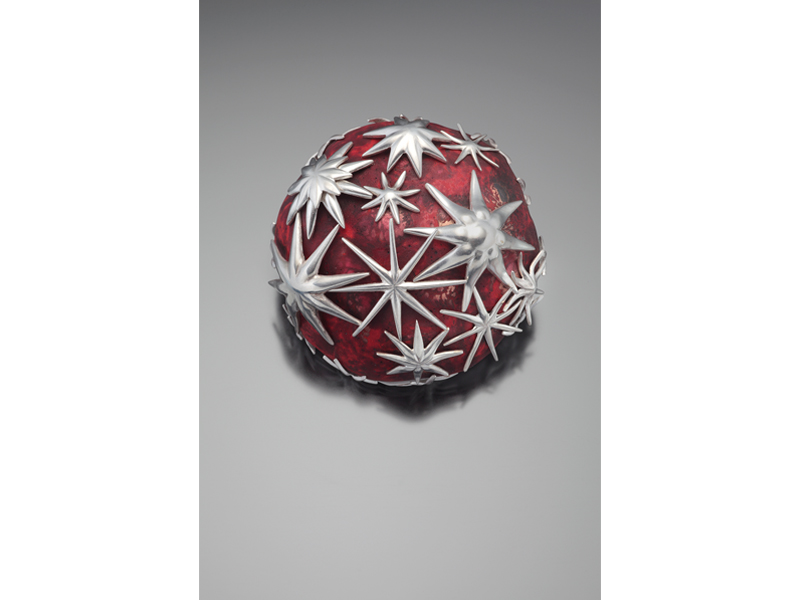
How do you use photography in your work?
Nancy Mēgan Corwin: I photograph the natural world at home and on every trip. There is such an abundance of source material that is unique to each area. The bromeliads and palms of Costa Rica are a wonderful contrast to the eucalyptus and coral of Australia. Many of the brooches I have been working on are a result of visiting Rottnest Island in Western Australia on one of my teaching trips. I loved the beaches, the tiny mussels clustered in the sand, the weather-worn rocks and strips of pastel seaweed. These photographs are an unending source of inspiration for forms and textures.
Do you consider your works in Marine Life Evolved at Facèré an extension of an existing evolutionary path, or a complete reimagining?
Nancy Mēgan Corwin: These works are thematically more closely related than previous pieces. They draw from the marine life and environments I experienced mainly in Australia and Canada. However, the addition of enamels is a new and exciting direction for my work. I wanted to bring into play the colors of the sea life, both in and out of the water.
What are you most proud of in this collection, and why? What were your biggest obstacles?
Nancy Mēgan Corwin: For many years I have been interested in adding enamel as a color and surface to my work without obscuring the chasing and repoussé underneath. There are two aspects to this endeavor. One is the technical difficulty of enameling on irregular three-dimensional surfaces, and the other is the development of a color palette that successfully works with these forms. I am for the most part self-taught in enameling. With lots of experimentation, and occasional help from my generous enameling friends, I feel that I have begun to achieve an exciting balance between texture and color.
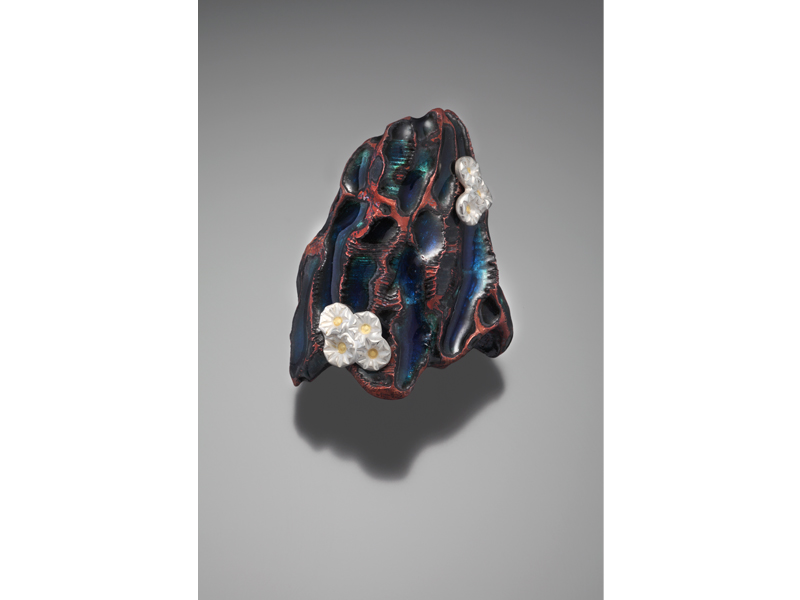
What are your thoughts on global warming and its impact on marine life? Do you think this question has a place in an interview about artistic practice?
Nancy Mēgan Corwin: This is an interesting question and one with a lot of relevance to my work. During my travels, I focus on native plant life and coastal areas, and speak with a lot of local people about the changes they have noticed. In every area, I hear about significant changes and, in many cases, reductions in the plant and marine life. The most dramatic was the Great Barrier Reef. On our snorkeling trip, it was emphasized over and over again the difference between the reef 20 to 50 years ago and now. In Costa Rica, guides talk about how rising water temperatures are affecting sea life, and changing weather patterns are impacting the rain forest. I may be more aware of this aspect of global warming than many people as I am always photographing the elements of the natural world that are deeply affected by these changes.
Which jewelry artists are you most excited by right now?
Nancy Mēgan Corwin: Julie Blyfield of Australia collects and is inspired by the plant material she finds in her environment. She uses minimal technique in a masterful way to create her various series of jewelry objects. I am impressed with her process and the immediacy of the work she produces. The theatricality of Kim Overstreet and Robin Kranitzky’s work is irresistible. They create little fantastical worlds that you can wear. Helen Britton is another jewelry artist whose work fascinates me. I love her sense of color and texture, and the care she takes with various materials.
Who do you consider to be pushing the boundaries of chasing and repoussé?
Nancy Mēgan Corwin: David Huang, who exhibits a strong sense of landscape in his chased vessel surfaces. Miel-Margarita Paredes is a sculptor who makes large-scale chased and repoussé pieces with a sense of humor and unique concept.
What would you like to work on next?
Nancy Mēgan Corwin: I’m continuing my work on the relationship between textural surfaces and enamel in jewelry. Outside of that, I have started a series of small vessels with stoppers that become necklaces. These vessels hold the memories of specific trips abroad, with the necklaces based on the natural world of that location.
What is the price range of your works in this show?
$200 to $2,000.
Thank you!
